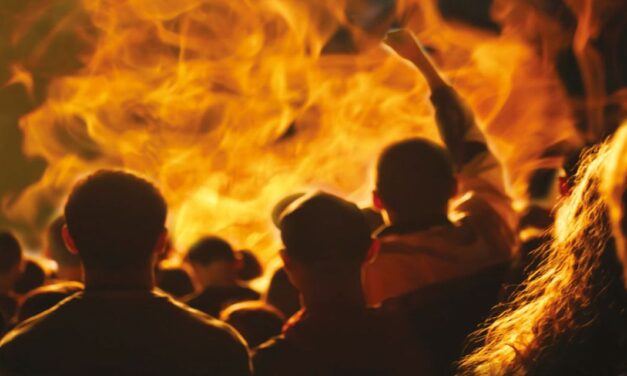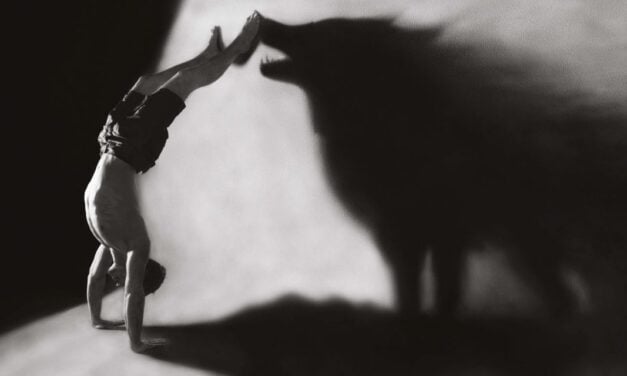This article first appeared in the Christian Research Journal, volume 46, number 1/2 (2023). Note: This is part of our ongoing Philosophers Series.
For further information or to support the Christian Research Journal please click here.
When you support the Journal, you join the team and help provide the resources at equip.org that minister to people worldwide. These resources include our ever-growing database of over 2,000 articles, as well as our free Postmodern Realities podcast.
Another way you can support our online articles is by leaving us a tip. A tip is just a small amount, like $3, $5, or $10, which is the cost of a latte, lunch out, or coffee drink. To leave a tip, click here
We saw fire in the streets across America in the hot, pandemic summer of 2020. Some were horrified and some were gratified. It all started after a short video was leaked to the press that showed a Black man dying on May 25, 2020, while a White police officer had him pinned to the ground with his knee. That man was crying out, “I can’t breathe!” That phrase became a rallying cry for those who saw the death of forty-six-year-old George Floyd as emblematic of racism in America. On this basis — and before a trial was held — hundreds of protests turned into riots across America.1 Not all were violent, but thousands of police were accosted, highways were blocked, businesses were looted, and federal and other buildings were set ablaze.
During this time, my wife, Kathleen, and I were away from our home in the Denver area and were assessing the upheavals from rural Alaska. Rioters had sacked the Denver capitol building and violence was afoot there, as well as across America. We wondered if even the suburbs where we lived were safe, since violence was escalating around the country. Thus, we seriously considered holing up in Alaska until things settled down. I called several friends and pastors and decided to return, although I could have taught my classes remotely, if needed. This was no paranoia but a sobering assessment of an unprecedented upheaval.
According to the Center for Disaster Philanthropy, between “May 25 and Nov. 18, 2020, protests occurred in more than 4,446 cities worldwide, including in all states, territories and Washington, D.C., and internationally in more than 60 countries.”2 Nineteen people were killed during the first two weeks of protests. Americans, especially those in inner cities, were on high alert all summer.3 Sales of guns skyrocketed, breaking records.4 Amid all this, we heard calls to “defund the police,” that America was “systemically racist,” and that White people experience an unjust “white privilege.”
For many, the death of George Floyd sparked a national “reckoning on race.” Some take it as the beginning of a positive revolution. Others fear it may mean the end of America as we know it. When added to concerns about the deaths of other Black people — such as Trayvon Martin, Michael Brown, and Breonna Taylor — at the hands of White police officers,5 Floyd’s dramatic and globally publicized death was the tipping point that drove people into the streets, often to commit violence and to advocate for defunding the police.
Some justified the extensive looting of the 2020 riots by saying that the rioters and looters who were people of color (POC) deserved the goods, since the owners’ insurance would replace the goods and pay for the damage. Vicky Osterweil, author of In Defense of Looting (Bold Type Books, 2020), told National Public Radio that “when I use the word looting, I mean the mass expropriation of property, mass shoplifting during a moment of upheaval or riot. That’s the thing I’m defending.”6 She wanted revenge on those who had supposedly succeeded unjustly at the expense of Black people.
But where do we stand three years after the riots have ended? While there were many reasons for the riots of 2020, one salient reason was an ideology called Critical Race Theory (CRT), a perspective that claims that America is systemically racist in principle and in practice, that the freemarket fosters racism, and that America as we know it needs to be replaced by an anti-racist socialist system.7 These are heady claims that require more analysis than I can give here, but let us begin.8
What Is Critical Race Theory?
In a nutshell, CRT developed from an earlier ideology called Critical Theory (CT), which was a form of neo-Marxism. Every aspect of society must be criticized and found wanting. Instead of dividing society into the two categories of the bourgeoisie owners (the oppressors) and the proletariat workers (the oppressed), as in Marxism, CT taught that oppression is woven into the fabric of culture and must be exposed through cultural critique. Through this critique, the culturally and economically oppressed can throw off their “false consciousness” (socially induced deceptions about their plight) and embrace a philosophy of liberation.
CT morphed into CRT when legal scholars began to add race to the mix, seeing racism as systemic in American life and evident in the law. Thinkers like the late Derrick Bell, best known for his work with the National Association for the Advancement of Colored People, argued that white racism has been a permanent feature of American life and could be countered only by revolutionary change in cultural and political values. Those advancing rights for sexual minorities (lesbians, gays, bisexuals, the transgendered) found the social system to be rigged against them, as well. Today, this amalgamation plays out in the following ideas, advanced by theorists such as Kimberlé Crenshaw, Robin DiAngelo, and Ibram X. Kendi.
- CRT claims that America is systemically racist and that the entire social system disadvantages POC — a term that includes all non-White people, but which usually refers to African Americans. Any discrepancy in the achievements between POC and White people is due primarily, or entirely, to this systemic racism, which is supposedly “baked into the system.” The claim of systemic racism is often accompanied by the idea that America has been racist from its beginning. The 1619 Project, a long-form journalism project of the New York Times that aims to reframe national history, claims that America was founded on racism when the first slaves were brought here in 1619.9 Any idea of “American exceptionalism” (in the good sense) is therefore deemed racist, xenophobic, white supremacist, and so on.
- All White people are racist, say CRT advocates. They grant that not all White people harbor explicit ill will toward POC, but since they are part of a racist system, they participate in racism simply by being White. They must be taught to realize this, which is the goal of the popular book White Fragility (Beacon Press, 2018) by Robin DiAngelo. White people, particularly heterosexual White males, are the oppressors in society.
- “White privilege” refers to the condition of unearned and unjust benefits — economic, cultural, and emotional —that POC and sexual minorities do not experience.
- “White supremacy” is the ideology that says White people will fight to keep their white privilege over POC, even if they do so unconsciously. This is a redefinition of the older definition, which emphasizes a conscious belief that Whites are superior to Blacks and should, therefore, control them.
- “Racial essentialism” is a tricky term. On the one hand, CRT says that race is “constructed” socially and not inherent in people. In this sense, it is postmodern. On the other hand, race is what determines whether one is oppressed or an oppressor. How this conflict is resolved escapes me, but perhaps it can be claimed that racial conceptions are constructed by the oppressors in order to oppress. As such, they are real. But in terms of one’s objective being, they are false.
- “Standpoint epistemology” is the belief that, unlike White people, POC and sexual minorities have a privileged perspective on matters of racial oppression. Their “lived experience” defines objective reality. If someone questions that perspective, he or she is assumed to be racist. Thus, former CNN host Don Lemon would often speak of “his truth” of experiencing racism and homophobia as a gay Black man, as do others seeking to advance this agenda. This approach denies any objective approach to truth.
- “Intersectionality” is an idea Kimberlé Crenshaw developed, holding that those who occupy several oppressed categories — such as a Black lesbian or a Hispanic transgender person — are particularly oppressed, and thus have a reliable vantage point to speak of the dynamics of oppression.10
- “Identity politics” is the norm among advocates of CRT. Instead of deeming individuals as “created equal” before God and the law, CRT understands individuals as members of a group who must be treated accordingly. Hence, the proliferation of hyphenated adjectives: African-American women, Hispanic-American men, and more.
- “Microaggressions” are commonly perceived by CRT enthusiasts. Given the above points, White people often disrespect and disadvantage POC through subtly abusive figures of speech and gestures. Given standpoint epistemology, a microaggression identified by a person of color or sexual minority cannot be questioned. The claim is based on the idea that language can be an act of violence, even if there is no ill intent.
- Free speech is not typically valued in CRT. Because of the points above, some speech is deemed tainted at the source and, as such, does not have the right to be heard. This is evidenced by the numerous public officials and private citizens who have been deplatformed at public events or banned from social media. CRT deems the older American notion of an open “marketplace of ideas” to be a prop for white privilege.11
I refer the reader to my book, Fire in the Streets, for a detailed analysis of CRT, but here we will focus on three themes: a biblical theology of race, the goodness of the American creed, and constructive ways to address racism.
The Bible and Race
While CRT starts with race and gender as the ruling aspects of being human, the Christian vision of humanity starts elsewhere — with God, in the beginning. Human beings are created in the image and likeness of God. On the sixth day of creation:
God said, “Let us make mankind in our image, in our likeness, so that they may rule over the fish in the sea and the birds in the sky, over the livestock and all the wild animals, and over all the creatures that move along the ground.”
So God created mankind in his own image,
in the image of God he created them;
male and female he created them.
God blessed them and said to them, “Be fruitful and increase in number; fill the earth and subdue it. Rule over the fish in the sea and the birds in the sky and over every living creature that moves on the ground.” (Gen. 1:26–28; see also 5:1–2; Ps. 8)12
Whatever the disputes on the biological and historical meaning of race, the Bible teaches there is but one human race. Humans find their origin and identity in the creative act of a personal God. We are finite and personal images of the infinite and personal God. Humans reflect and represent the agency, creativity, rationality, and relationality of their Creator. Our first parents were created with the purpose of marrying, procreating, and thriving in the creation of culture. Humans have a God-given dignity, nature, and purpose in His world. Human life is not to be taken through murder since people bear God’s image (Gen. 9:6; Exod. 20:13). Nor should anyone be libeled or slandered, given their status as image bearers of God (Exod. 20:16; Matt. 5:21–23; James 3:9–10). Racial epithets and slurs are, therefore, condemned.
When Paul preached to the philosophers on Mars Hill in Athens, he challenged his learned audience by claiming that God has made all people — including the Athenians listening to him — from one man. “From one man he made all the nations, that they should inhabit the whole earth; and he marked out their appointed times in history and the boundaries of their lands. God did this so that they would seek him and perhaps reach out for him and find him, though he is not far from any one of us” (Acts 17:26–27).
The Athenians proudly traced their origin to their own Greek soil, from which they sprang unique and which made them superior to those of other races. This was ethnocentrism, if not racism. Yet Paul affirms the unity and equality of humanity. All the nations — and thus all the peoples — of the world receive their objective value and purpose from their Maker. One’s fundamental identity is being made in the Divine Image; it is not found in race or gender or social class.
Our first parents, whatever color they may have been, listened to the deceiving serpent, turned against God, were expelled from the garden, and brought a curse upon creation (Gen. 3). Just as all human beings came from one man, so through that man sin and death came into the world (Rom. 5:2). “All have sinned and fall short of the glory of God” (Rom. 3:23). This is a universal judgment on all races, all people, and throughout all history (except for the sinless Jesus [Heb. 4:15]). The Bible knows nothing of any hierarchy of sinners by race or by any other innate quality. We all sin because we are all sinners, and we all need redemption through one God-man, Jesus Christ (1 Tim. 2:5). “But the gift is not like the trespass. For if the many died by the trespass of the one man, how much more did God’s grace and the gift that came by the grace of the one man, Jesus Christ, overflow to the many!” (Rom. 5:15).
Jesus commissioned His followers to take the gospel to all people, as He told His disciples, “But you will receive power when the Holy Spirit comes on you; and you will be my witnesses in Jerusalem, and in all Judea and Samaria, and to the ends of the earth” (Acts 1:8; see also Matt. 28:18–20).
Given these realities, Christians should love and respect all people, irrespective of their skin color or ethnicity. Moreover, they should desire that all people thrive and be treated fairly in society. But some think America is so racist that it must be overturned through a revolution.
The Meaning of America
The 1619 Project claimed that America was based on racism and built on racism. As Black Lives Matter leader Hawk Newsome put it, “If this country doesn’t give us what we want, then we will burn down this system and replace it. All right? And I could be speaking figuratively. I could be speaking literally. It’s a matter of interpretation.”13 Given the riots of the summer of 2020, we know what the proper interpretation was.
Although America allowed slavery, its essential creed denied it, since the Declaration of Independence says, “We hold these truths to be self-evident, that all men are created equal, that they are endowed by their Creator with certain unalienable Rights, that among these are Life, Liberty and the pursuit of Happiness.”14
The author of the Declaration was Thomas Jefferson, a man conflicted about slavery and who owned slaves. A man’s ideals may be better than his practice. So, too, for a nation. The Declaration set the tone for the American experiment, raising the bar higher than America had yet reached. But later, pivotal American leaders took the Declaration as a clarion call for freedom for all people, despite the stain of slavery. No less than Abraham Lincoln, Frederick Douglass, and Martin Luther King Jr. all believed the Declaration set the tone for emancipation and equal participation for Blacks in society.15
Yet CRT advocates and others claim that our very Constitution enshrined slavery, thus proving that the United States is fundamentally racist. This bogus claim rests on a misinterpretation of the three-fifths clause (Article 1, Section 2), which says that states can count each slave as three-fifths of a person for the sake of congressional representation. Rather than deeming slaves (the word is not used) as three-fifths human, this clause was a compromise between the Northern and Southern states. Since slavery could not be directly undermined in the Constitution without alienating the Southern states, the anti-slavery delegates wanted to make “the political base of slavery as weak as possible, to diminish its influence and improve the chances of eradicating it sometime in the future.”16
Thus, this clause of the Constitution was a compromise between the pro-slavery Southern states and the anti-slavery Northern states and was, in fact, a ticking time bomb that detonated at the Civil War. The three-fifths compromise had nothing to do with slaves being viewed as three-fifths human; rather, it allowed the Northern delegates to limit the political power of the South, who would not let their slaves vote anyway.
The CRT ideology is revolutionary; it wants to tear down America qua America and replace it with a socialist system where “diversity, equity, and inclusion” will be mandated from the top down, without respect to individual ability, private property rights, or the positive possibilities of a genuinely free market. But our Constitutional Republic is a far better system than any socialist alternative, since it provides a solid foundation on which to build, and upon which to improve through amendments to the Constitution and through cultural and political change within the guardrails of the Constitution.
Addressing CRT and Racism Today
CRT appeals to many because it promises a way to address racism and to create a better society. However, given its roots in atheistic Marxism, its overemphasis on race, and its rejection of American ideals, it provides no way forward. What can be done if we leave CRT behind?17
First, we need to understand the power of ideas — true and false. CRT is built on the sand of a false philosophy and should be exposed as such (Col. 2:8). Since Christianity is true, rational, and applicable to all of life, it has the power to conserve what is good, expose what is evil, and transform what needs to be improved. Christians should, thus, outthink and out-live the world for Christ!
Second, we should teach civics about the history and nature of the American system in public and private schools. There is much good to be reaffirmed about the Declaration of Independence, the Constitution, and about American history. The claim that we need CRT to address America’s failures concerning race is false. Civics can be taught while emphasizing the sins of America against Blacks, American Indians, and others. However, minorities have gained rights and opportunities throughout American history — something that CRT advocates deny.
Third, Christians should work to break down barriers that keep ethnic groups separate or suspicious of each other. We are all part of the Body of Christ (1 Cor. 12–14; Gal. 3:26–28) and have much in common as believers, whatever differences exist. Our unity is based on a grand spiritual reality in Christ that is beyond skin color or cultural background. Ministries such as The Center for Biblical Unity can be of help. It is co-led by Monique Duson, who was once deceived by CRT but has found a better and more biblical way.18
CRT is an untrue and un-American ideology that provides no help for the racial troubles of America. Its claim that racism is at the heart of all the major problems of society is overstated, and its reliance on an essentially Marxist view of society is false and poisonous. Although the challenge of racism in America is real, CRT neither offers insights into its nature nor provides alternatives to address these wrongs. The Christian worldview offers a true account of race, sin, and society that is far superior to that of CRT.
Douglas Groothuis, PhD, is Professor of Philosophy at Denver Seminary. Among his many books are Christian Apologetics: A Comprehensive Case for Biblical Faith, 2nd ed. (IVP Academic, 2022) and Fire in the Streets: How You Can Confidently Respond to Incendiary Cultural Topics (Salem Books, 2022).
NOTES
- For an assessment of the facts of the matter, see “Fire in Our Own House,” in Douglas R. Groothuis, Fire in the Streets: How You Can Confidently Respond to Incendiary Cultural Topics (Washington, D.C.: Salem Books, 2022). This essay is largely adapted from this book.
- “U.S. Civil Unrest,” Center for Disaster Philanthropy, June 25, 2021, https://disasterphilanthropy.org/disasters/u-s-civil-unrest.
- Jemima McEvoy, “14 Days of Protests, 19 Dead,” Forbes, June 8, 2020, https://www.forbes.com/sites/jemimamcevoy/2020/06/08/14-days-of-protests-19-dead/?sh=61f6c0984de4.
- Douglas A. McIntyre, “This Is How Many Guns Were Sold in All 50 States,” 24/7 Wall St., February 3, 2021, https://247wallst.com/consumer-products/2021/02/03/this-is-how-many-guns-were-sold-in-all-50-states/.
- For a detailed and surprising assessment of these kinds of cases, including George Floyd, see David Horowitz, I Can’t Breathe: How a Racial Hoax Is Killing America (Washington, DC: Regnery, 2021).
- Natalie Escobar, “One Author’s Controversial View: ‘In Defense of Looting,’” Code Switch, NPR, August 27, 2020, https://www.npr.org/sections/codeswitch/2020/08/27/906642178/one-authors-argument-in-defense-of-looting.
- See, e.g., Ibram X. Kendi, How to Be an Antiracist (New York: Random House, 2019).
- See Groothuis, Fire in the Streets.
- See “The 1619 Project,” New York Times Magazine, August 14, 2019, https://www.nytimes.com/interactive/2019/08/14/magazine/1619-america-slavery.html. Editors’ note: For refutations of The 1619 Project, see Peter W. Wood, 1620: A Critical Response to The 1619 Project (New York: Encounter Books, 2020), and Mary Grabar, Debunking The 1619 Project: Exposing the Plan to Divide America (Washington, D.C.: Regnery History, 2021).
- Kimberlé Crenshaw, “Demarginalizing the Intersection of Race and Sex: A Black Feminist Critique of Antidiscrimination Doctrine, Feminist Theory and Antiracist Politics,” University of Chicago Legal Forum, vol. 1989: iss. 1, art. 8, http://chicagounbound.uchicago.edu/uclf/vol1989/iss1/8.
- See Alan Dershowitz, The Case Against the New Censorship (New York: Hot Books, 2021).
- Scripture quotations are taken from NIV.
- Hawk Newsome, quoted in Mark Moore, “BLM Leader: If Change Doesn’t Happen, Then ‘We Will Burn Down This System,’” New York Post, June 25, 2020, https://nypost.com/2020/06/25/blm-leader-if-change-doesnt-happen-we-will-burn-down-this-system.
- Declaration of Independence, America’s Founding Documents, National Archives, https://www.archives.gov/founding-docs/declaration-transcript.
- See Groothuis, Fire, 49–52.
- Robert A. Goldwin, “Why Blacks, Women, and Jews Are Not Mentioned in the Constitution,” Commentary, May 1987, https://www.commentary.org/articles/robert-goldwin/why-blacks-women-jews-are-not-mentioned-in-the-constitution.
- For more, see Groothuis, “Fanning Holy Flames,” in Fire in the Streets.
- The Center for Biblical Unity, https://www.centerforbiblicalunity.com.










